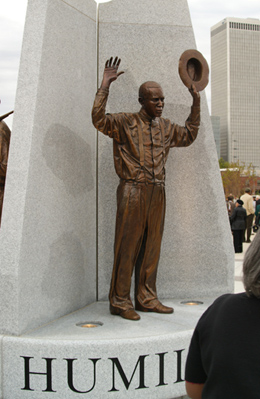
TULSA, Oklahoma — The AFL-CIO’s vacation guide pamphlet, “Inventory of American Labor Landmarks,” has no section for Oklahoma, but travelers should consider going to the city’s John Hope Franklin Reconcilliation Park anyway. The tiny park commemorates the biggest race riot and massacre of American history. Plaques at the park tell the story…
On May 31, 1921, a young shoe-shine man, Dick Rowland, tripped as he stepped off a downtown elevator. For balance, he accidentally grabbed the arm of the elevator officer. Sarah Page, a white woman, screamed for the police. Rowland ran, but was eventually arrested and thrown into jail. Newspapers screamed terrifying headlines that inferred an interracial rape might have taken place. That night, a lynch mob gathered at the jail and demanded Rowland. A few African American war veterans armed themselves and came to save the young man. One of the white men tried to disarm a veteran, and his firearm went off in the scuffle.
Almost immediately, thousands of whites crossed the railroad tracks to invade the relatively prosperous African American business district and burned it to the ground. They also ransacked and burned an estimated 1,200 homes and killed at least 300 citizens. It was a classic American pogrom.
Tulsa leaders whitewashed the events and kept them almost completely secret until well after the civil rights upsurge of the 1960s and 70s. When the story became known, they put up a nice park on the site of the massacre. There are three outstanding statues. “Hostility” is taken from an old photograph of an overly armed white man smoking a cigar. “Humiliation” is from another photo of an African American baring his head as he subjugates himself to the mob. “Hope” shows a man holding a baby.
After we read the plaques and view the statues, we can find a few benches where we can sit down, hold our heads in our hands, and weep.
Photo: Flickr (CC)












Comments